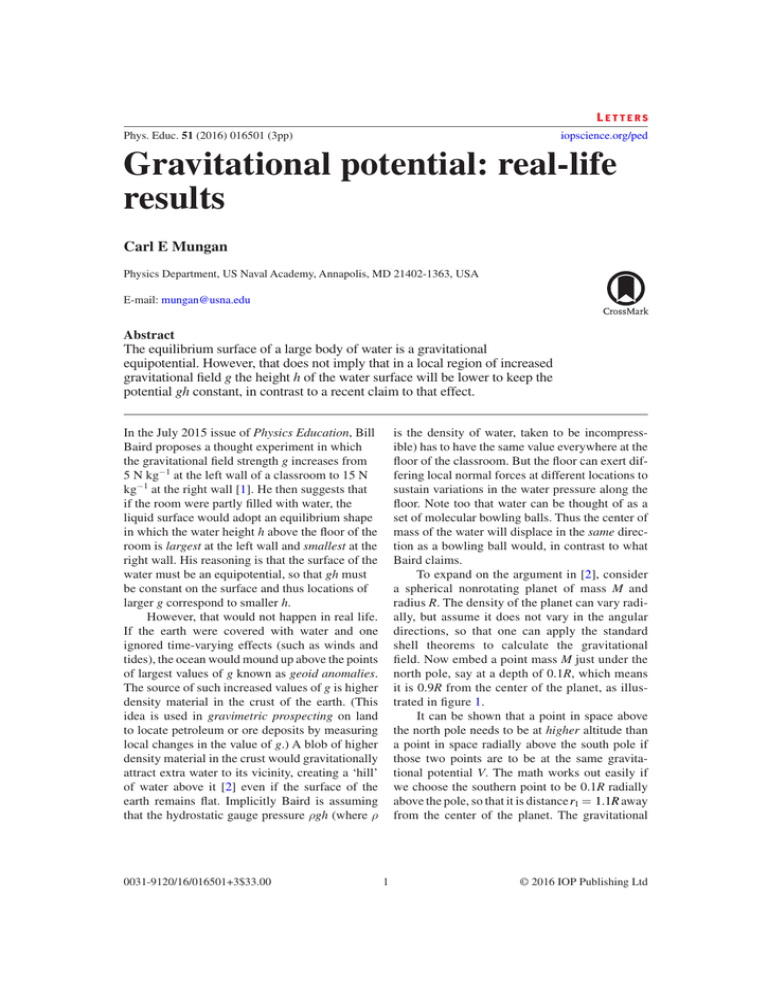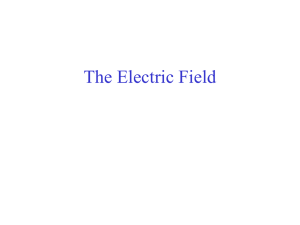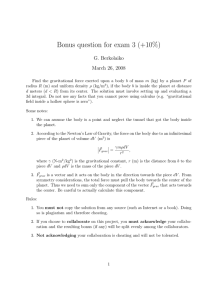Physics Education is the density of water, taken to be incompress-
advertisement

Letters Phys. Educ. 51 (2016) 016501 (3pp) iopscience.org/ped Gravitational potential: real-life results Carl E Mungan Physics Department, US Naval Academy, Annapolis, MD 21402-1363, USA E-mail: mungan@usna.edu Abstract The equilibrium surface of a large body of water is a gravitational equipotential. However, that does not imply that in a local region of increased gravitational field g the height h of the water surface will be lower to keep the potential gh constant, in contrast to a recent claim to that effect. is the density of water, taken to be incompressible) has to have the same value everywhere at the floor of the classroom. But the floor can exert differing local normal forces at different locations to sustain variations in the water pressure along the floor. Note too that water can be thought of as a set of molecular bowling balls. Thus the center of mass of the water will displace in the same direction as a bowling ball would, in contrast to what Baird claims. To expand on the argument in [2], consider a spherical nonrotating planet of mass M and radius R. The density of the planet can vary radially, but assume it does not vary in the angular directions, so that one can apply the standard shell theorems to calculate the gravitational field. Now embed a point mass M just under the north pole, say at a depth of 0.1R, which means it is 0.9R from the center of the planet, as illustrated in figure 1. It can be shown that a point in space above the north pole needs to be at higher altitude than a point in space radially above the south pole if those two points are to be at the same gravitational potential V. The math works out easily if we choose the southern point to be 0.1R radially above the pole, so that it is distance r1 = 1.1R away from the center of the planet. The gravitational In the July 2015 issue of Physics Education, Bill Baird proposes a thought experiment in which the gravitational field strength g increases from 5 N kg−1 at the left wall of a classroom to 15 N kg−1 at the right wall [1]. He then suggests that if the room were partly filled with water, the liquid surface would adopt an equilibrium shape in which the water height h above the floor of the room is largest at the left wall and smallest at the right wall. His reasoning is that the surface of the water must be an equipotential, so that gh must be constant on the surface and thus locations of larger g correspond to smaller h. However, that would not happen in real life. If the earth were covered with water and one ignored time-varying effects (such as winds and tides), the ocean would mound up above the points of largest values of g known as geoid anomalies. The source of such increased values of g is higher density material in the crust of the earth. (This idea is used in gravimetric prospecting on land to locate petroleum or ore deposits by measuring local changes in the value of g.) A blob of higher density material in the crust would gravitationally attract extra water to its vicinity, creating a ‘hill’ of water above it [2] even if the surface of the earth remains flat. Implicitly Baird is assuming that the hydrostatic gauge pressure ρgh (where ρ 0031-9120/16/016501+3$33.00 1 © 2016 IOP Publishing Ltd C E Mungan potential at this southern point is then the sum of that due to the planet and the added mass, V1 = − GM GM GM GM − =− − . r1 r1 + 0.9R 1.1R 2R (1) Next we want to find the point above the north pole at distance r2 from the center of the planet that has this same potential. We again do a sum, but this time the added mass is on the same side of the planet’s center as the field point of interest, so that the plus sign in the second denominator becomes a minus sign, GM GM V2 = − − . (2) r2 − 0.9R r2 If we set the right-hand sides of equations (1) and (2) equal to each other and solve for r2, we get a quadratic equation. Only one root is larger than R, which is the one we want. By direct inspection of the two equations, we see that the answer is r2 = 2R. Therefore, if we were to cover the surface of the planet with water such that the water above the south pole were 0.1R deep, then the water above the north pole would be R deep. The water is higher where the total gravitational field is stronger. The key point is that it is not possible for a static gravitational field to point everywhere vertically while having a strength that varies horizontally. Say it has the form −kx ^j where k is a Figure 1. Two points (indicated by asterisks) radially above the north and south poles at which the gravitational potentials V1 and V2 are equal, due to the net gravitational field produced by an off-center point object and the extended planet, both of mass M. ends to two vertical pipes. Now place a point mass directly underneath one end of the U-tube and fill it with water. The resulting gravitational field will cause the water to move as close to the point mass as it can. Hence there will be more water in the vertical tube under which the point mass is located (where the gravitational field is stronger) than in the other, more distant vertical tube. The equipotentials are concentric spheres centered on the point mass. In like fashion, the water surface in Baird’s room must curve upward to the right and be concave downward, unlike what is drawn in figure 1 of [1]. constant. Such a field would not be irrotational (curl-free). The line integral of g around the black loop indicating the ceiling, right and left walls, and floor in figure 1 of [1] would be nonzero, so that the field could not be the gradient of a potential. In reality, the field must also have a horizontal component, and consequently there is a horizontal component of the gravitational force on any cubic element of fluid which balances the pressure difference on the left and right faces of the element, preventing that bit of water from being ‘squeezed’ into lower g regions. A similar explanation has recently been presented to explain the tidal bulge for a water-covered planet [3]. Imagine an isolated U-tube in outer space, consisting of a horizontal pipe connected at its January 2016 Acknowledgments I thank Joel Helton and Bill Baird for helpful discussions. Received 13 July 2015, in final form 1 October 2015 Accepted for publication 8 October 2015 doi:10.1088/0031-9120/51/1/016501 2 P h y s i c s E d u c at i o n Gravitational potential: real-life results References Carl Mungan is an associate professor of physics with research interests in laser optics and solidstate spectroscopy. [1] Baird W H 2015 Gravitational potential: a thought experiment Phys. Educ. 50 397–8 [2] http://principles.ou.edu/earth_figure_gravity/ geoid/ [3] Ng C-K 2015 How tidal forces cause ocean tides in the equilibrium theory Phys. Educ. 50 159–64 January 2016 3 P h y s i c s E d u c at i o n Frontline iopscience.org/ped Gravitational potential: a thought experiment William H Baird Department of Chemistry & Physics, Armstrong State University, Savannah, GA 31419, USA E-mail: william.baird@armstrong.edu Abstract The electrostatic potential is a key element of the second semester of introductory physics. Teaching about its gravitational analog in the first semester allows students to make more connections between the two courses. The use of a simple thought experiment with an unexpected outcome provides a method for introducing gravitational potential in a way students may remember. Introduction When teaching the second semester of introductory physics, the parallels between electrostatics and gravitation are too numerous to ignore [1]. Since gravity is something students have always had both a figurative and literal ‘feel’ for, connecting that knowledge to the new world of electric charges (where physical intuition is in comparatively short supply) can be expected to ease their discomfort. Coulomb’s law and Newton’s law of universal gravitation are obvious partners, and the respective fields produced by point charges and point masses are similarly related. As conservation of energy is both a bedrock principle of physics and one of the core methods used to solve problems in the first semester, it is no surprise that it appears again when discussing electric charges. There may be a bit of difficulty at this point, however; while there are two forms of gravitational potential energy that students should remember (PE = M2gh near the surface of the Earth, for h small when compared to Earth’s radius, and PE = −GM1M2/r in the general case), introducing the electrostatic equivalent as PE = q ΔV raises the question of what the voltage difference ΔV really represents. This author was surprised to learn during the peer review process that the gravitational analogue of voltage, known as the gravitational potential, is a commonly discussed topic in physics courses in the UK. Examination of popular textbooks used in the USA, however, yields a different picture. Reviewing both calculus-based [2–4] and algebra-based [5–7] texts shows full chapters on electrostatic potential (except for reference [7], where electrostatic potential shares a chapter with the electric field), but no mention of gravitational potential, even in the indices. The decision to omit the gravitational potential may be forgiven in light of the material to be covered in a typical 14- or 15-week course; after all, when so many topics in introductory physics are tightly connected to each other, gravitational potential seems to be a bit of an isolated case. It is useful when discussing an idealized model of tides in which the Earth is a perfect sphere covered by a layer of water of uniform depth, and it also appears when considering the general relativistic effect of gravity on time, either of which may or may not be mentioned in a year-long university physics course. The idea, if not the name, does appear in the form of the old adage ‘Water seeks its own level’. A student’s physics book may include a representative picture (e.g. reference [2], page 392) of vessels of widely varying shapes and areas 0031-9120/15/040397+2$33.00 © 2015 IOP Publishing Ltd Physics Education 50 (4) 397 W H Baird Figure 1. A plot of the local acceleration due to gravity across a classroom. g (dotted green line) is imagined to vary from 5 m s−2 at the left edge of the figure to 15 m s−2 at the back. The water level (solid blue line) is shown to be highest where g has its minimum magnitude. connected to a common reservoir and sharing a common depth of fluid (though probably without mention of the gravitational potential). An instructor could be expected to introduce gravitational potential as being the gravitational potential energy per unit mass (yielding either Φ = gh or Φ = −GM/r, depending on the proximity to Earth). Explaining that g is approximately constant everywhere along Earth’s surface then reveals exactly why water would ‘seek its own level’. The surface is merely an equipotential surface. If we scoop water out of a pool, the surrounding water will rush in to fill the hole. As an aside, this provides a neat analogy for the next semester when considering the fact that added charges will quickly arrange themselves on the surface of a conductor such that the metal is an equipotential volume. The unexpected result comes when we propose a thought experiment: imagine the classroom is watertight and filled to half of its capacity with water. Of course, it will have the same depth everywhere in the room. Now imagine we have the ability to change g anywhere in the room. We choose to make it equal to 5 m s−2 along the front wall and 15 m s−2 along the back wall, varying smoothly between them (figure 1). First, we ask if/where a bowling ball placed in the centre of the room (empty of water in this case) would roll. Students generally agree it would move towards the most negative value of g, the back of the room where g = 15 m s−2. 398 P h y s i c s E d u c at i o n We now ask what the result of adding half of the room’s total volume in water will be. Many students (and not a few physicists) may initially assume that the water, like the ball, will ‘want’ to gather on the high-g side of the room and that the water depth will be greatest there. At that point, we can remind them that the surface of water is to be an equipotential, so the side with the largest g will have the smallest h. The bowling ball moves towards one side and the water piles up on the opposite side. The water’s greater weight ‘squeezes’ it out of the high-g region into the lowg region. Introducing your first-semester students to the gravitational potential may require some careful subject rearrangement, but your students (and colleagues) will thank you when discussing voltage in the second half of the course. Received 18 December 2014, in final form 19 February 2015 accepted for publication 16 April 2015 doi:10.1088/0031-9120/50/4/397 References [1] Saeli S and MacIsaac D 2007 Using gravitational analogies to introduce elementary electrical field theory concepts Phys. Teach. 45 104–8 [2] Walker J, Halliday D and Resnick R 2014 Fundamentals of Physics 10th edn (Hoboken, NJ: Wiley) [3] Knight R D 2013 Physics for Scientists and Engineers: a Strategic Approach 3rd edn (Glenview, IL: Pearson Education) [4] Serway R A and Jewett J W Jr 2010 Physics for Scientists and Engineers 8th edn (Belmont, CA: Brooks/Cole Cengage) [5] Cutnell J D and Johnson K W 2012 Physics 9th edn (Hoboken, NJ: Wiley) [6] Giordano N J 2013 College Physics: Reasoning and Relationships 2nd edn (Boston, MA: Brooks/Cole Cengage) [7] Etkina E, Gentile M and Van Heuvelen A 2014 College Physics 1st edn (Glenview, IL: Pearson Education) Bill Baird is an associate professor of physics at Armstrong State University, Savannah, GA, USA, where he has taught for ten years. His primary research interest is the design, construction and use of sensors. July 2015





